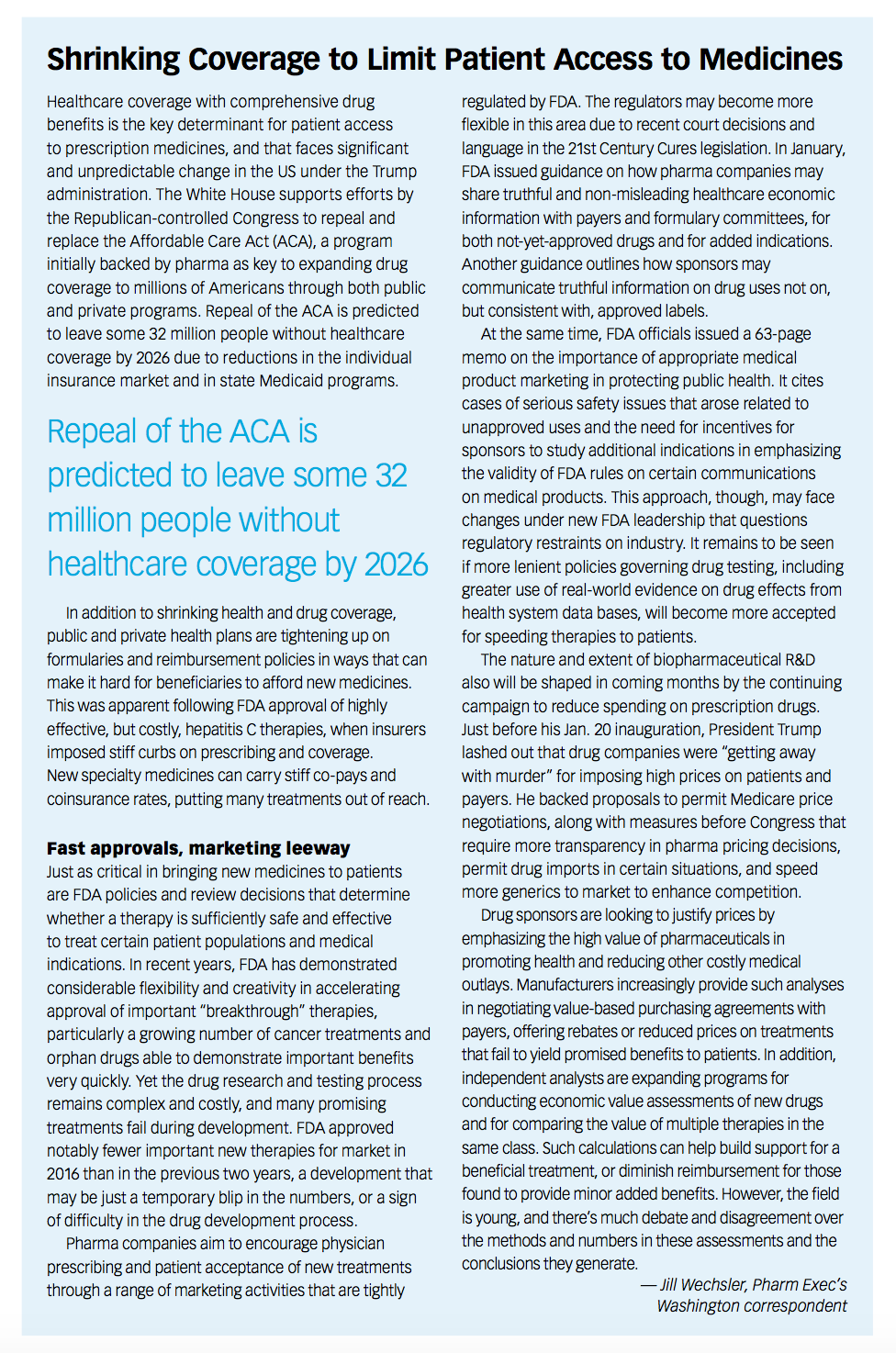Market Access: Current and Future States
Pharmaceutical Executive
With the push toward value-based heathcare set to accelerate even more in 2017, Takeda’s VP of global market access discusses the evolution of this all-important engine for medical innovation and bottom-line returns.
Pharm Exec recently spoke with Mel Formica, vice president of global market access with Japanese drug giant Takeda, about what he sees as the challenges and opportunities for the market access function in 2017, and how he envisions the industry’s capabilities in this area evolving.
PE: What, for you, will be the key market access developments in 2017?
Formica: I think the biggest focus in the next 12 months, predominantly on the US and European side, is going
Mel Formica, Takeda's vice president of global market access

to be around the issue of affordability. Complicating the US side, the new Trump administration will potentially create some uncertainty in that environment, as we know. So there will be a need to evaluate the policies his administration may enact. Trump has indicated that he wants to go after pricing, but will it be just select companies and select pricing events that he wants to showcase?
One of the subtle differences between the US the Europe in terms of affordability is that the EU is going to start to address more aggressively combination therapies, where you have multiple high-price drugs coming together, particularly in the oncology space.
PE: Are we likely to see more HTA harmonization or more fragmentation in Europe?
Formica: It depends how we think of harmonization. I don’t see a central HTA (health technology assessment) being established in Europe within the next one to two years. There will be continued discussion and movement toward the value of a harmonized relative-effectiveness body, and the smaller member states have a lot of benefit to gain from that. But the larger member states-Germany, France-are not that willing to give up their value frameworks and decision-making processes to a central body. What may move quicker is joint procurement, and this is already where we’re starting to see clusters of member states-for example, around Benelux and the southern borders of Italy, Spain, and Greece-wanting to get together and look at increasing their purchasing power.
PE: What are your thoughts on Brexit from a market access perspective?
Formica: I’m not envisioning a major detrimental impact to the UK because of Brexit, largely because I imagine NICE (National Institute for Health and Care Excellence) will continue to be completely independent of the EU, and will drive its agenda and policies. A bigger issue is that Brexit could lead to fundamental changes to market regulation, increased costs, and additional complexity. One risk area is if the UK is no longer part of the EMA (European Medicines Agency) regulatory process. A parallel regulatory process with different requirements could increase cost and complexity of gaining approval in the UK, or could cause companies to deprioritize the UK as a launch market.
PE: NICE has also influenced the US’s Institute for Clinical and Economic Review (ICER). Do you see that institute making headway in the US this year?
Formica: I think it will create opportunities for industry. But there were already health technology assessments in many of the larger US health plans, of course, and it is unlikely that we will see more centralized technology assessment in the US in the near future. Groups like
Patient-Access Perils in the US (click to enlarge)

ICER will continue to carve out their space, and health plans and payers will continue to use this information as negotiating tools. Where I see opportunities for industry in the US is in a greater drive toward value-based healthcare. With that comes the onus of measuring outcomes, creating payment models for those outcomes, and creating quality standards.
The accountable care organizations will also continue to drive more innovation. They are taking a pathways approach to how they think about managing their budgets, their diseases, and their populations. This is an opportunity for industry to innovate because it will see industry as more of a solution provider, helping the care organizations see a longer-term perspective around the pathway of the patient’s journey.
PE: Will the lack of a cohesive HTA structure continue to be a barrier to market access in the emerging markets?
Formica: I see emerging markets essentially in three tiers. There is a tier of markets that I wouldn’t call “developing”-Brazil, Mexico, China, etc. They’re probably as developed as some of the peripheral markets in Europe. You then have a tier-the Philippines, Thailand, India-where the ability to pay even for more general medicines can be a struggle, and where paying for specialty medicines is extremely difficult. If you are serious about wanting to bring innovation into those markets, then the issue is how do you equitably help people where the vast majority of the country could never access those medicines or be able to afford them? The third tier requires a more philanthropic approach with access to medicine initiatives.
If we look at that “first tier,” Brazil, for example, has an HTA and it is relatively sophisticated. Brazil may not have the local expertise to fully make decisions based on the HTA, but it looks at the evaluation and uses it more as a negotiating rather than a decision-making tool. There is still an element of advocacy that plays in markets like Brazil: relationship building, knowing the different stakeholders. Those are the capabilities you need to be successful in those markets, along with some technical capabilities.
PE: Would you say there is a current shortage of market access competencies across the pharma industry?
Formica: Yes, my biggest hurdle is the recruitment of appropriate talent. I can find good technical people, good pricing people, good healthcare outcomes researchers. There is always room for more talent in access with leadership behaviors and business acumen. The ability to engage different functions internally, and external stakeholders, is still key.
PE: How do you see the market access function evolving? Is “market access” even the right term for it?
Formica: I don’t believe market access, or whatever we end up calling it in the future, is a function, per se. I think it is an organizational capability. If you truly want to be successful at getting your product to the patient and contributing to a sustainable, affordable healthcare system, you have to have throughout your organization a certain mindset, a certain DNA. The function within the company that drives that thinking will evolve significantly from market access as we define it today.
I see market access as two sides of one coin. On side is the organization’s ability to address national or quasi-national payer decision-making. This effectively means how you think about creating the value proposition for the payer early in a product’s life cycle, how you develop the evidence base, how you think of pricing models for that value and how you communicate that at a national level. The second side of that equation is more to do with commercial access. When you’ve got past the national system, there is a fragmentation of local and regional insurances and sick funds; there is a whole bunch of payers, including patients, in that spectrum. How are we as an organization addressing the needs of those payers? How are we thinking about our account management? The ability to fund and pay and make decisions around utilization are changing. So, do we need to rethink the construct of how our field-based teams talk about and defend things like price and value?
Julian Upton is Pharm Exec’s Online and European Editor. He can be reached at julian.upton@ubm.com

Trump: 'Major Tariff' on Pharmaceuticals Coming Soon
Published: April 9th 2025 | Updated: April 9th 2025“We’re going to tariff our pharmaceuticals, and once we do that, they are going to come rushing back into our country," President Donald J. Trump said during a Tuesday night dinner in Washington.